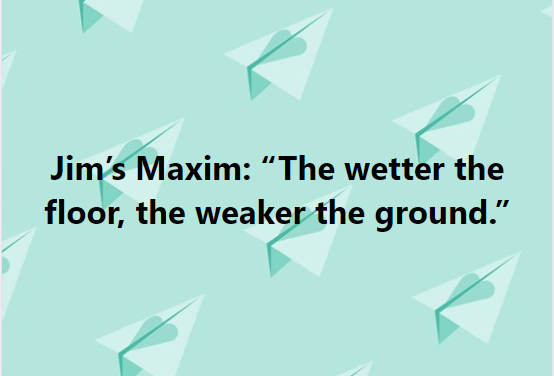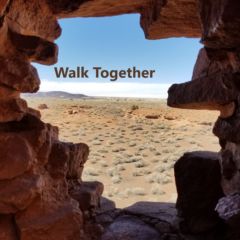Just how big is $1.9 trillion Relief? If you place a Republican and a Democrat on opposite ends of a wormhole across the known universe then count the miles apart ... 1.9 trillion.
Author: James Butler
Jim’s Maxim

Played out in risk sensitive fields. The electric outlet not GFCI protected becomes the favorite to run extension cords out to parties on wet grass. The corporate exec who uses “password” as password.
As a pastor and insurance adjuster, this maxim to capture the Delta-V of where you are likely to experience a loss. It is a moving target. In my last church, now over 80 years old, we inspected and protected every outdoor outlet with GFCI “ground fault” protection. To my shock (forgive the pun), the lawn carnival, water slide vendors, not finding a nearby outlet, opened the nearest door and plugged extension cords into 20 amp nonprotected electrical outlets.
Using “Jim’s Maxim,” the jump-house people, who assured us that all their equipment was “GFCI protected,” admitted to me they either didn’t have GFCI or forgot to bring it. Now we had 500 youth and children on campus to enjoy the nearly inflated water slide. We had a choice – shut down the main event …. or make a Home Depot run for a solution:
Solution: a 20 amp GFCI extension cord.

-Pastor Jim
Costco Lady in the Mask
Today I exited Costco of Prescott with two $43 boxes of Newman’s coffee pods and two bags of cauliflower tortillas and 3 bags of Keto cereal, placed the items inside the rear hatch of my Acadia, and pressed the hatch close button. Then I saw a 4×4 pickup waiting for my spot like a Robin for a worm. So, I plopped behind the wheel, removed my Covid mask and visor, backed out and pulled forward a few feet. The pickup crept behind me like someone lacking social distancing. But there in center isle ahead a silver haired woman cut across my path, with a blue face mask that covered all but her blue eyes … focused on me.

Is she looking for her car? Did she need help? Was she disoriented? I don’t feel like socializing. Great, now she’s pointing. Is she pointing to her spouse in a vehicle behind me? Now I’m caught between this lady’s hand signals and her husband. Did she belong with the 4×4 truck who couldn’t get into my space? I wondered how much patience this truck would tolerate this wayward senior. This turned into a scene.
Oh, no. She did not gesture at another vehicle but waved at me. Still pointing at some mysterious apparition. So I accepted my duty to assist the poor woman. I put on my face visor like crooked glasses, rolled down my window and greeted her. She crept to my driver’s door, bent her head and whispered loudly for the hearing impaired, still pointing, ” Did you know your rear hatch is up?”
Glancing in my rearview, I indeed saw my hatch up and the 4×4 still idling, now with other cars gathering behind it. Certainly their conversation swirled around the poor old man rescued by the silver sneakered doo-gooder. Because the two Costco size coffee boxes blocked the electric door path, I had to exit the cab, wave at the sympathetic eyes of those watching a man about to scatter 200 coffee pods across six lanes of traffic.
The silver angel disappeared with approving nod and hidden masked grin of “I told you so.” The truck parked. Traffic passed.
As I left Costco, I called my wife who said, “You see, you can’t go to Costco without me!” I have advanced to the ranks of I can’t go anywhere without my wife, and she has proof. What’s next? Coffee cup on the roof? Card left at the register? (I did check for that before I left the lot).
Self-checkout: In our mid-Covid, post-Capitol time of prepare for the worst and trust no one, I had a masked reminder of why we need each other. We need to learn to trust again. Kindness cannot exist without trust. When I roll my window to give a dollar to a homeless person, I take a trust risk. When I pause to help one who lost her way, I trust that I won’t lose my way. Kindness shown means kindness received. Rather than a political agenda, let us muster a kindness agenda.
Love is patient, love is kind. - I Corinthians 13
– Pastor Jim
“Grandpa, What’s an election?”
“Grandpa, what’s an election?” A: “An election gives people a voice to choose between a Republican or a Democrat lawsuit.”
National Treasure

The Caregiver

Political Pigs in the Parlor

The Day the Easter Bunny Came to Church
Standing for the truth makes us roar!
Have you ever been placed in a position where telling the truth cost you? As I pastored my second church in a farming community in rural Arizona in the early 1990’s, a new epidemic swept the land — AIDS, and the fear associated with it. We thought we were secure and better than that, considering that AIDS was a blight on those “less than Christian.”
Then the day came when a young man, we’ll call “Jamie,” returned from college. Jamie was the son of one of the most prominent families in our church. Jamie was sick. His mother met with me and explained that Jamie returned home with AIDS and must now undergo treatment at a Phoenix medical center, with an uncertain prognosis. As Jamie and his family sat in a forward pew with other relatives seating behind, we served Holy Communion by intinction. We would serve the bread, which the congregants would dip into the cup.
Word spread through the church faster than a brush fire that Jamie had AIDS. As it is with gossip, a conspiracy theory spread that Jamie and his family were exposing the congregation to AIDS. Now at the time, we offered Communion by traditional plastic cups and wafers in another service, but battle lines were drawn over the AIDS patient in church.
To allay the fears of the church members, we invited a speaker to address the church on AIDS and educate us so that we might not worship in fear. The speaker that night suffered from hemophilia, a disease that prevents blood from clotting. He told about the hundreds of hemophilia patients who tragically received AIDS tainting blood transfusions who later died. What was a seminar to allay fears turned into proof that the church was at risk of catching AIDS via Communion. But I made a decision — because we offered two different methods of Communion in two different services, the church members could choose which to attend. Some were happy and some were not.
One Sunday in Easter season, I made the announcement to the children present for the children’s sermon, “Today, boys and girls, we have a special guest. The Easter Bunny has come to church. Please come forward to meet him.” As the kids came forward, Jamie came up with them and sat on the chancel steps next to me. The kids sat wide-eyed and silent waiting for the appearance of the Easter Bunny.
I explained, “Jamie raised pygmy bunnies at his farm and he brought one for us today.” Jamie produced the tiniest and purest white bunny with ruby-red eyes and gently placed it in my cupped hands on the purple velvet of my clergy robed lap. The children sat enraptured by the beautiful gentle creature. We then took a few moments and spoke about the meaning of Easter and the new life given by Jesus Christ.
As I gently placed the bunny in Jamie’s palms, the children returned to their pews. Some months later, as I drove the youth to church camp, my pager went off, and without voicemail or cell phone, I knew what the vibrations meant. Before we left for camp, I asked the church secretary to page me if Jamie died, as his condition had been deteriorating. I turned the van around and drove back to the church to comfort the family.
Today, looking back over 45 years of ministry and sermons. Some worth listening to and some not. The best sermon ever told was the day the Easter Bunny came to church and when Jamie placed that tiny white velvet bunny in my palms. That was a gift of God’s grace.
Some day you may be called upon to deliver a message of God’s truth. You may be asked to deliver grace and truth in a time of fear. You may be slandered because of your truth. Jamie, even while certain church members wagged their fingers at him behind his back, sat in a circle of children and his pastor and presented a message of God’s grace incarnate.

Citizens for a Fauci First-Class postage stamp.

He is Risen,
Pastor Jim
Separation of Church and State of Mind
The Evangelical church in the U.S. suffers from a lack of separation of church and state of mind.
-Pastor Jim
Up Next “Separate Church and Hate”
From Lock Up to Look Up

The Dreamers in the United States teach to sing a song about a perfect symphony about what life could be.
